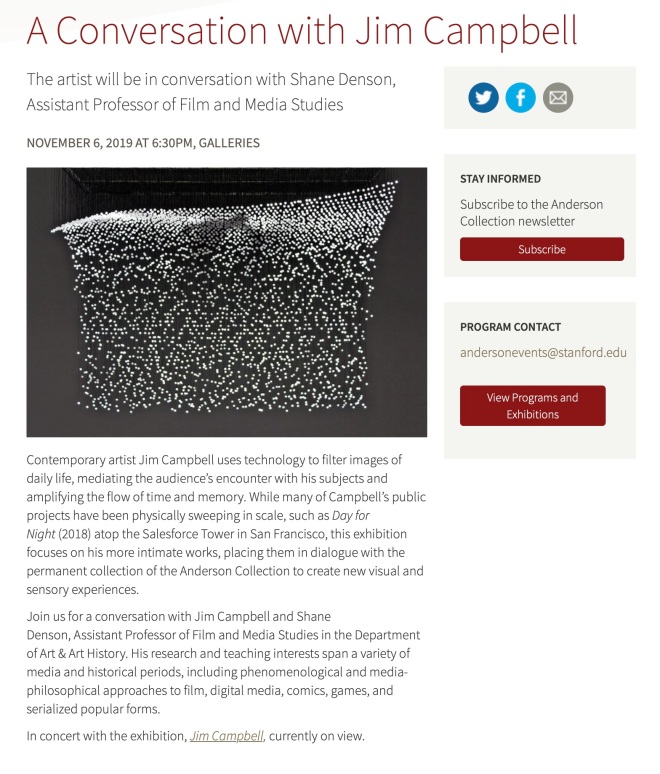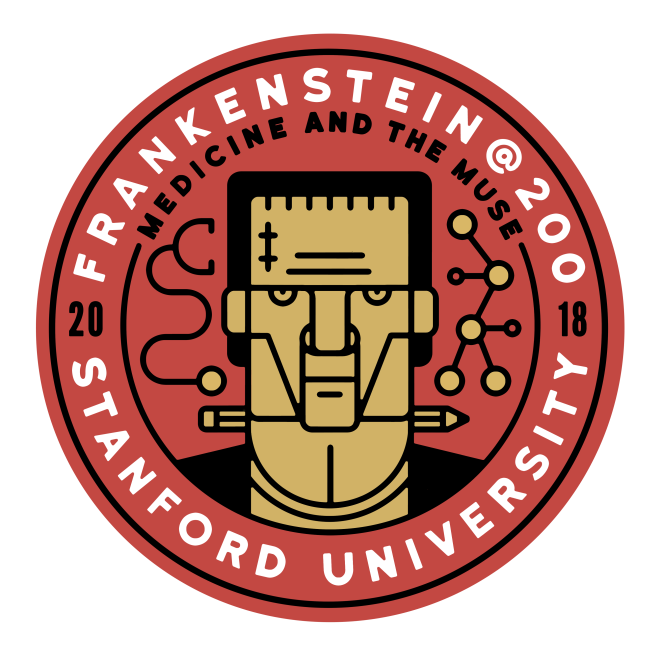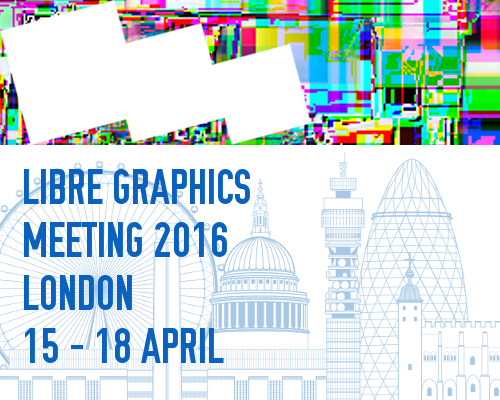Next Wednesday, November 6, 2019, I will be in conversation with media artist Jim Campbell at the Anderson Collection at Stanford, where a stunning exhibition of his LED-based works is currently on show.
Tag: Art
Let’s Make a Monster — Exhibition at Shriram Center for Bioengineering and Chemical Engineering

Works from the course “Let’s Make a Monster: Critical Making,” which I co-taught this quarter with my art practice colleague Paul DeMarinis, are currently on display in the Shriram Center for Bioengineering and Chemical Engineering at Stanford University. The show, which officially opened today, is up through Friday, June 8.
We are particularly excited to take this work across campus and show it in the context of a space devoted to cutting-edge engineering work, where we hope that it provokes thought and discussion about the transformations of technology, experience, and life itself taking place in Silicon Valley and elsewhere. Thanks especially to Prof. Drew Endy for his help in facilitating and making this show possible.
Here are just a few glimpses of the work on display.
Nora Wheat, Decode (2018)
Hieu Minh Pham, The Knot (2018)
Raphael Palefsky-Smith, Brick (2018) — more info here
David Zimmerman, Eigenromans I-III (2018)
Jennifer Xilo, Mirror for Our Upturned Palms (2018)
Jackie Langelier, Creepers (2018)
Syllabus: Let’s Make a Monster! Critical Making (Stanford, Spring 2018)
Somehow I forgot to post the syllabus for “Let’s Make A Monster! Critical Making,” which Paul DeMarinis and I are currently teaching as a hybrid Film & Media Studies and Art Practice class in the Department of Art & Art History at Stanford. The main focus of the course, as the title indicates, is the production of monsters in a variety of media and informed by reading literary, philosophical, and other critical texts on making and monstrosity. Students have been making some truly astounding work, and I look forward to being able to present some of it later in the quarter. We will be organizing an exhibition of works on campus, and I will post images here.
Let’s Make a Monster! Critical Making (Stanford, Spring 2018)

Ever since Frankenstein unleashed his monster onto the world in Mary Shelley’s novel from 1818, the notion of “technology-out-of-control” has been a constant worry of modern societies, plaguing more optimistic visions of progress and innovation with fears that modern machines harbor potentials that, once set in motion, can no longer be tamed by their human makers. In this characteristically modern myth, the act of making — and especially technological making — gives rise to monsters. As a cautionary tale, we are therefore entreated to look before we leap, to go slow and think critically about the possible consequences of invention before we attempt to make something radically new. However, this means of approaching the issue of human-technological relations implies a fundamental opposition between thinking and making, suggesting a split between cognition as the specifically human capacity for reflection versus a causal determinism-without-reflection that characterizes the machinic or the technical. Nevertheless, recent media theory questions this dichotomy by asserting that technologies are inseparable from humans’ abilities to think and to act in the world, while artistic practices undo the thinking/making split more directly and materially, by taking materials — including technologies — as the very medium of their critical engagement with the world. Drawing on impulses from both media theory and art practice, “critical making” names a counterpart to “critical thinking” — one that utilizes technologies to think about humans’ constitutive entanglements with technology, while recognizing that insight often comes from errors, glitches, malfunctions, or even monsters. Co-taught by a practicing artist and a media theorist, this course will engage students in hands-on critical practices involving both theories and technologies. Let’s make a monster!
ARTSTUDI 233, FILMSTUD 233/433 — Spring 2018 — Profs. Paul DeMarinis & Shane Denson — Thursdays 3:00-5:50pm
Out Now: ETC Media 110
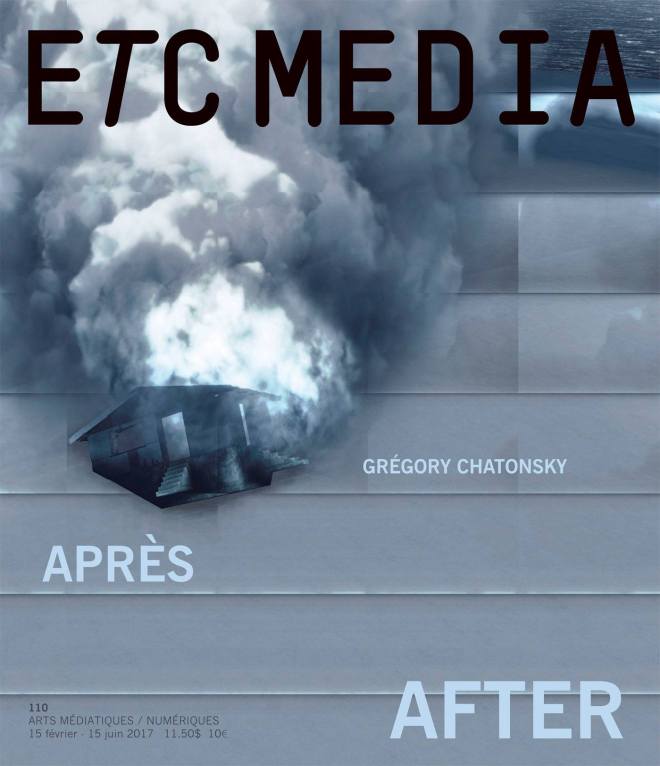
I am proud to have a piece on “Pre-Sponsive Gestures” and the work of French media artist Grégory Chatonsky included in the new issue of the Montreal-based ETC Media. Looks like a great issue, and happy to be in such good company!
CURRENT ISSUE // 110
GRÉGORY CHATONSKY: APRÈS LE RÉSEAU / AFTER THE NETWORKIssue 110 of ETC MEDIA is dedicated to Grégory Chatonsky, who has curated the form and content of this special issue. A Montreal resident for the last ten years, the artist is a pioneer of net art, founding Incident.net in 1994, and an unflagging explorer of the relationships between technology and anonymous existence. In this issue, the artist and a few other friends, artists, philosophers, art historians, and art critics reconsider the last two decades of experimentation, a time in which the world drastically changed through the widespread use of the Internet to reach a digital omnipresence that heralds a near extinction. Divided into 3 sections—“infinitude,” “hyperproduction,” “without ourselves”—ETC MEDIA becomes a platform for navigating in our era and gaining a better understanding of a future whose portents remain deeply ambivalent—promising and threatening all at once. Rather than being reduced to trendy notions often misunderstood by the contemporary art milieu, the concepts of post-digital, accelerationism, and speculative materialism constellate a world in the process of perishing and being born.
Collaborators
Grégory Chatonsky
Eve K. Tremblay
Pau Waelder
Bertrand Gervais and Arnaud Regnauld
Shane Denson
DeForrest Brown Jr.
Goliath Dyèvre
Pierre Cassou-Noguès
Erik Bordeleau
Nora N. Khan
Dylan Trigg
Pierre-Alexandre Fradet
Jussi Parikka
Frankenstein@200
Happy to be on the steering committee for Frankenstein@200 — a year-long series of events taking place at Stanford in 2018. I’ll be participating in a number of ways, including talks and several courses related to Frankenstein, among other things. I’ll post details here in due time. Also be sure to check out the project website, which is still under construction, but which is already chock full of announcements and constantly being updated.
The year 2018 marks the 200th anniversary of the publishing of Mary Shelley’s novel Frankenstein. The novel is eerily relevant today as we face ethical dilemmas around appropriate use of stem cells, questions about organ donation and organ harvesting, as well as animal to human transplants. Additionally, the rise of artificial intelligence portends an uncertain future of the boundaries between machines and humans. Frankenstein@200, will be a year-long series of academic courses and programs including a film festival, a play, a lecture series and an international Health Humanities Conference that will examine the numerous moral, scientific, sociological, ethical and spiritual dimensions of the work, and why Dr. Frankenstein and his monster still capture the moral imagination today. This project will be sponsored by the Stanford Medicine & the Muse Program in partnership with the Stanford Humanities Center, the Stanford Arts Institute, the Office of Religious Life, the Vice Provost for Teaching and Learning, Stanford Continuing Studies, the Cantor Arts Center, the Department of Art & Art History, and the Center for Biomedical Ethics.
Post-Cinema AR
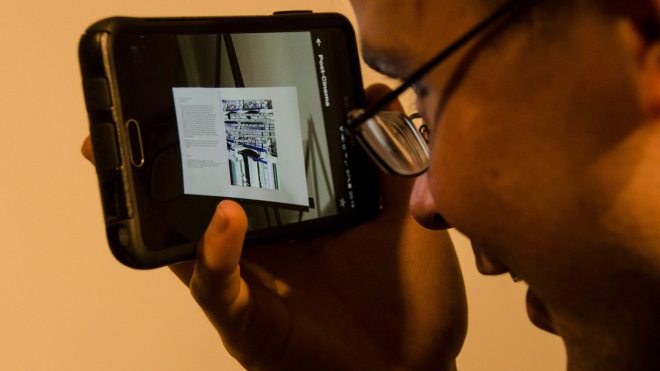
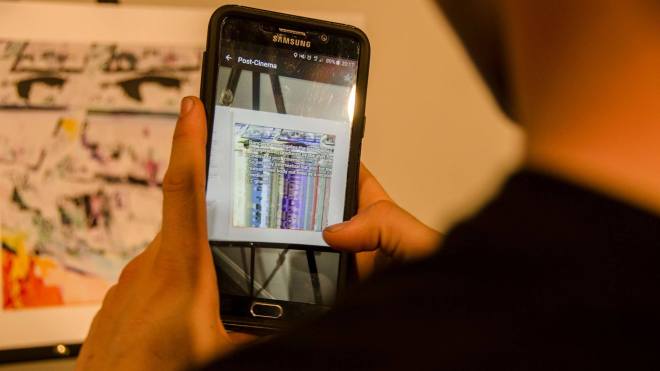
The augmented reality piece featured on the cover of Post-Cinema: Theorizing 21st-Century Film (http://reframe.sussex.ac.uk/post-cinema/), a collaborative piece made by Karin Denson and me, was displayed recently at a glitch-oriented gallery show organized by some nice people associated with Savannah College of Art and Design.
Try it out for yourself here: http://reframe.sussex.ac.uk/post-cinema/artwork/.
After.Video at Libre Graphics 2016 in London
Recently, I posted about a project called after.video, which contains an augmented (AR) glitch/video/image-based theory piece that Karin Denson and I collaborated on. It has now been announced that the official launch of after.video, Volume 1: Assemblages — a “video book” consisting of a paperback book and video elements stored on a Raspberry Pi computer packaged in a VHS case, which will also be available online — will take place at the Libre Graphics Meeting 2016 in London (Sunday, April 17th at 4:20pm).
